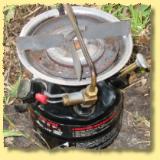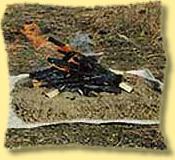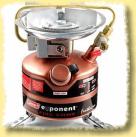
Minimize Campfire Impact

A nation that destroys its soils destroys itself. Forests are the lungs of our
land, purifying the air and giving fresh strength to our people. |
 What is camping without a fire?
What is camping without a fire?
A fire means heat, light, and life. To many people, a campsite with no fire is just not camping. A campfire means self-sufficiency, survival, and comfort. Our view of campfires is built on centuries of tradition and historic need.
Fortunately, there are many places to camp where a fire is completely appropriate, safe, and welcome. You might even want to build a fire pit in your own backyard.
The ability to enjoy an outdoor adventure with alternate heat and light sources greatly expands your opportunities and allows a more self-sufficient experience. The development of lightweight, very efficient camp stoves has eliminated the real need for a fire in most circumstances so it is now a choice to use a fire or a stove.
Why Have a Fire?
- Warmth - a fire warms you on a cold camping trip, but there are much better ways to stay warm. Bringing appropriate clothing and having healthy food means less need for fire. Campfire heat is useful for drying clothing and warming water to put in a bottle in your sleeping bag to make it more comfortable.
- Cooking - whether it is boiling water or cooking meat, a fire is used to prepare food for consumption.
- Entertainment - watching the flames is relaxing and telling stories around a fire is a great way to complete a strenuous day in the woods.
 Campfire Alternatives
Campfire Alternatives
On any outdoor adventure, a source of heat for emergencies is required. You should always be prepared to start a fire in a survival situation. But, a backpacking stove is a great alternate source of heat from the campfire. Stoves have many benefits over fires:
- Fast - stoves have nearly instant, ready-to-cook heat. No waiting for the fire. They also extinguish immediately.
- Clean - stoves have no smoke and leave no ash or partially-burned wood. They do not create soot on pots.
- Safe - the risk of wildfire is nearly eliminated with stoves.
- Consistent - stoves work at nearly any elevation, temperature, and elevation.
 Choosing Fire or Stove
Choosing Fire or Stove
Before heading out on a wilderness adventure, it is a good idea to decide whether campfires or stoves will be used for each day of the trip. It may be decided to have campfires some days and stoves on others. Some things to consider when making the decision include:
- Fire Danger - what will the wind conditions, humidity, and vegetation dryness be like for the location and season?
- Fire Restrictions - contact the local land managers to find out what types of fires are allowed in the area.
- Fuel Availability - is there adequate fuel so fires will not deplete or impact the resource?
- Group Skills - is everyone in the group able to safely build and tend fires?
- Menu - will the food the group takes cook better over a stove or fire?
Leave No Trace Campfires
Once the decision is made to have a fire, the expertise of minimizing its impact comes into play. There will be an impact to the area from any fire, but there are many ways to reduce and disguise the impact.
- Use existing fire rings - in an established campsite, use the fire ring
- If there is no fire ring, do not make one. Instead, build a mound fire.
- Build small fires - create a fire just large enough to cook the food. Feed it fuel as needed.
- Burn all wood to ash - stop adding fuel to the fire well before bed-time or departure time so it has time to burn itself out. This prevents having chunks of partially burned wood to disperse.
- Gather firewood carefully:
- Use wood that is down. Leave limbs on standing trees, even if they are dead limbs.
- Use wood that is smaller around than an adult's wrist. It should be broken by hand - no saws or axes are needed.
- Leave larger logs and limbs for habitat and to decompose into the soil.
- Take a hike out away from camp to gather wood. Leave close-in wood so it can decompose into the soil.
- Clean up after the fire:
- Scatter unused wood as naturally as possible.
- Push unburned ends of wood into the fire as it burns down so it is all consumed.
- When the coals have burned to ash, soak well with water and make sure it is completely out. Use water rather than dirt to put out the fire.
- Collect the cold ash and scatter it over a large area well away from the camp site.
Fires built on the ground overheat the organic soil and kill the creepy crawlies living in it. It may take a very long time for anything to grow in the spot where a fire was built. An established fire ring is a sacrificed spot in which fires are accepted to prevent destruction of other areas.
In the absence of fire rings, rather than creating a fire directly on the ground, it is better to insulate the organic soil from the heat of your fire by using a camp stove, fire pan, or mound fire.
Fire Pans
A collapsible fire pan is a good way to have a campfire and greatly reduce its impact. A metal pan with 3-inch sides perched on 4 or 5 stones allows a fire without scorching the soil underneath. Follow all Leave No Trace campfire guidelines listed above.
 Mound Fires
Mound Fires
Another way to insulte soil is to cover it with a few inches of mineral soil and build a fire on that. Mineral soil is found underneath the top layer of rich, darker, organic soil. Mineral soil, sand, or gravel do not have the thriving life in them that organic soil has so a fire on that material is ok.
To create a mound fire, follow these steps:
- With a small shovel or trowel, gather sand or mineral soil into a bag. Good places to look are the root ball of a blown-down tree or a dry creekbed. The bag can be a stuff sack turned inside out to keep the inside clean.
- Lay a groundcloth on the spot where the fire will be built. This makes clean up easier. Some sparks will land on the cloth and it will be worn and dirty from the ground so use something sturdy and expendable.
- Pour the sand onto the groundcloth. Flatten the top of the pile so the mound is at least 4 inches thick and bigger around than what the fire will be.
- Use the Leave No Trace campfire guidelines listed above.
- After cleaning up the campfire, return the soil to its orginal location and clean away and spills at the fire site.
For more campfire information, please visit Campfire Dude.
 Tips on Minimizing Campfire Impact
Tips on Minimizing Campfire Impact
- Prepare the group's expectations so they are aware of what fires will be used.
- Practice with the stoves being used so everyone is competent in their use.
- Take advantage of weather information for last minute planning.
- Take along a few candles. Use these in place of a campfire in your evening meeting place.
- The stars and darkness are a fun change from a campfire and storytelling can be more exciting.
Minimizing Campfire Impact is Important because:
- fires are potentially the most dangerous and expensive impact we might do
- it is the only LNT principle aimed to control consumption of resources
Examples To Consider
 | After cooking breakfast over a fire, cleaning the dishes, and picking up camp, it was time for a morning hike. The fire had completely burned out over an hour ago so no one thought to douse the fire ring with water. While the group was away, the wind picked up. |
| The group that camped here gathered huge rocks for a fire ring, left lots of unburned wood, and did not disperse the waste or return the rocks to their original locations. Others have noticed the ring and even laid tinder in it but from the surrounding fragile vegetation, it looks like this spot is not highly used. A smaller fire and better clean up may have helped prevent future campers from congregating here. |  |
 | A group began a 6-day backpacking trip during a dry spell but there was no fire ban. Two days into their trip, they met a ranger patrolling the wilderness and he informed them that a fire ban had been instituted that morning. They are either stuck with eating cold food, building illegal fires, or using a back-up stove they brought just in case. |
Debate the Principle
There may be reasons to make different choices when considering this Leave No Trace principle. Here are a few to think about:
- Stoves are expensive to manufacture, creating pollution and consuming resources somewhere. There may be less overall impact from simply burning wood than using stoves. The impact is in a different place on the globe.
- Stoves burn fossil fuels which are non-renewable and cause pollution to manufacture.
- Disposal of stove fuel cannisters or bottles should also be considered.
Teaching Minimize Campfire Impacts
- General Teaching Advice - good ways to get people to learn
- Activity - Fire Race - compare stoves and fires
- Activity - Bare Ground - deplete fuel supplies

